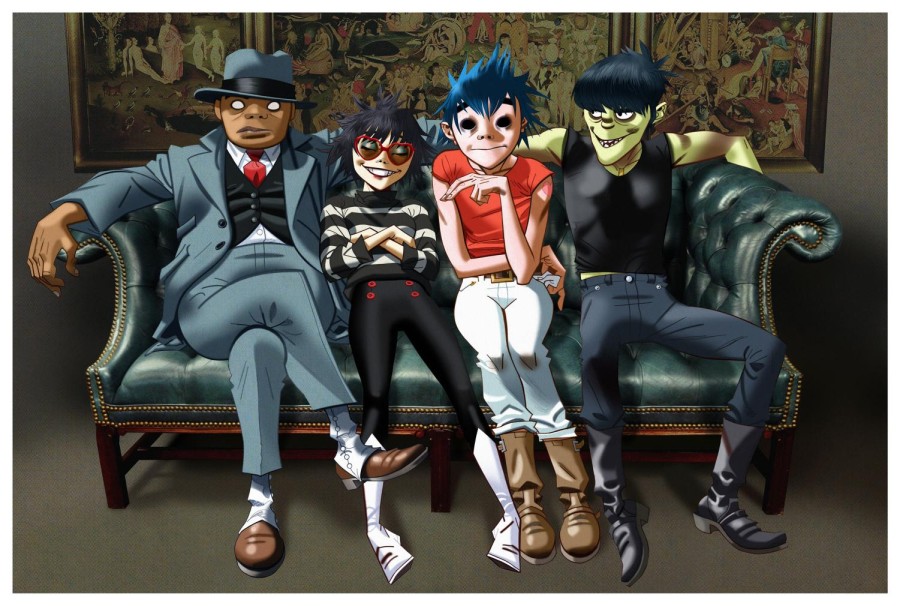Review: ‘Cracker Island’ is, underwhelmingly, Gorillaz as usual
“Cracker Island” stays true to Gorillaz’s established sound but it’s not on the level of originality as some of their iconic past heights.
March 28, 2023
Damon Albarn and Jamie Hewlett’s alternative band is back with “Cracker Island.” First created in 1998, Gorillaz is a fictional band composed of the animated bandmates 2-D, Noodle, Murdoc Niccals and Russel Hobbs. The storyline of Gorillaz gets more complex with every album, and “Cracker Island” is no different. Adding onto the band’s rich lore, “Cracker Island” takes place on the in-universe location of Cracker Island, much like its 2010 album, “Plastic Beach.”
The band’s eighth studio album, “Cracker Island” runs at a tight 37 minutes with a 10-song tracklist.
“Cracker Island” is a well-rounded Gorillaz album that fits nicely into the group’s discography. It’s very safe and in line with the band’s well-developed sound, but it lacks the dramatic flair that Gorillaz is known for. The album moves through emotional, colorful and funky melodies that are equal parts pop and fan-friendly, while touching lightly on topics like over-consumption of media and addiction to technology.
In usual Gorillaz fashion, there are a litany of features in the album that create an exciting mishmash of different genres and styles. This remains a focal point of the album, and is well exemplified by the opening and title track, “Cracker Island.” It’s a catchy tune with heavy synths, all backed by a dense bass part and ad-libbing from R&B artist Thundercat. The opener is an intense song that feels almost haunting in its refrains, setting the stage for an album that attempts to be grandiose but ultimately doesn’t deliver.
The first half of the album continues to build on a sentimental sound and themes with tracks like the soulful “Oil,” featuring the deep vocals of Stevie Nicks, which contrast Albarn’s more vibrant performance. While her presence is pleasant, Nicks is underutilized in the song as she is largely relegated to only singing chorus backing. It’s possible this feature may have been more impactful had it gone to The Strokes frontman Julian Casablancas, as was originally intended, according to an interview between Radio X and Albarn,
Track five, “New Gold,” features legendary alt-rock group Tame Impala, as well as rap artist and The Pharcyde founding member Bootie Brown. “New Gold” sounds like both an iconic Tame Impala track and a classic Gorillaz track, and is buoyed by its mix of hip-hop and noisy production. The buildup to the beat drop feels straight out of a 2000s EDM track, harkening to Gorillaz’s classic style. While Brown’s verse isn’t anything particularly lyrically impressive, when Kevin Parker and Albarn come together over the final chorus the song becomes undeniably special.
The second half of the album starts with “Baby Queen” which, according to music news outlet NME, is based on Albarn’s memory of meeting the princess of Thailand at a Blur concert in 1997. This song poses as a kind of nighttime pondering of an alternate life, one where Albarn had taken a different path, maybe even getting to know the princess of Thailand. It’s interesting that Albarn recounts a real-life experience with this song rather than constructing a fictional narrative from the perspective of 2-D, as he usually does. This may signal a turn for Gorillaz’s manner of world-building — perhaps Albarn will continue to use the fictional bandmates as a direct vessel for actual life events. Despite the pleasant lyrical nature, it’s one of the multiple tracks that feel forgettable across the second half of the album.
What isn’t forgettable, however, is the fifth track, “Tormenta,” which features Bad Bunny over a laid-back reggae instrumentation. It’s an entertaining track that feels like it could be played at a club. Bad Bunny takes major control of the song, almost making it feel as if Gorillaz is the featured artist rather than the other way around — which isn’t necessarily a bad thing.
The ninth track, “Skinny Ape,” sees 2-D in a hopeless but still upbeat song about moving on, anchored by a catchy neo-psychedelic chorus. The folk-rock introduction is contrasted by the more electronic build as the song progresses. It’s probably the album’s best individual track, bordering on absurd at times with lyrics like, “I’m a skinny little, skinny little, skinny little, skinny little / Ape, ape, ape, ape, ape, ape, ape, ape (ape).” It’s one of the rare times on this album that Gorillaz comes off as actually innovative and fresh — no previous song of theirs comes close.
“Cracker Island” is a solid album, but not exceptional. There aren’t any notably bad songs, and there are a few innovative tracks that will definitely stand out for years to come. Unfortunately, many of the tracks are predictable and unmemorable in the grand scheme of the Gorillaz canon.
Contact Anuj Jain at [email protected].
























































































































































